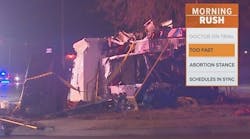"So this is Christmas, and what have you done?" While John Lennon penned these introspective words over 35 years ago, they still raise a good question today, especially for us in the American Fire Service.
When it comes to firefighter safety, what have you done? Have you taken the lead on safety within your fire department? Have you shown courage in confronting someone who performed an unsafe act? Have you shown leadership and modeled safe behaviors in the last year? If you cannot answer the above questions with positive replies or affirmative answers the next question becomes, why not?
When it comes to firefighter safety the end of the year becomes a good opportunity to reflect and consequently make commitments for the coming year. So, here are three more questions along with some possible answers for you to consider. Hopefully, these thoughts will help to better yourself for modeling courageous leadership in the coming year.
Where is the safety bar set?
When reflecting on your own fire department consider where the safety bar is set when it comes to firefighter safety. Honestly assess whether safety principles are adhered to or if safety is just a buzz-word. You can tell this if you just look around the station, or when your company answers a call, or on the scene of an emergency. When safety is merely a buzz-word it shows up in the station when firefighters demonstrate malaise or general indifferent attitudes to most things but especially training sessions and safety discussions. When safety is not really important it shows up on the calls as no seatbelt usage, driving recklessly, and rushing too much at the scene of an emergency. When safety is mere lip-service, fire officers look the other way when they see infractions. Finally, if most firefighters think of safety as an after thought your agency is in trouble.
With all of the above examples, what may have occurred is something similar to an organizational drift. One sociologist has even coined a phrase that describes this drift as a human phenomenon. Diane Vaughan wrote a book in 1996 entitled The Challenger Launch Decision where she chronicled the tragedy and blamed the decision to launch the Challenger on "normalization of deviance". Vaughan describes normalized deviance as a long term situation in which individuals or teams accept lower standards or performance until that lower standard becomes the "norm".
Normalized deviance is reinforced in the "getting away with it" over and over, until a point in time comes when no one sees the behavior in question as deviant. Vaughan describes in her book how the Challenger tragedy of February 1986 was caused due to O-ring failure because of sub-freezing temperatures. The morning that the Challenger was launched, the O-rings had become brittle and while engineers knew of this hazard, a culture of compliance to a lower standard led them to believe that it was an acceptable risk. The decision was made to go ahead with the launch and the rest is history.
It is easy to see a parallel with the fire service. When a safety malaise or the "looking the other way" culture has developed then the bar has been lowered. Then, quite possibly, the bar or standard can go lower and maybe it is a matter of time before the inevitable happens. (Does Charleston come to mind?) Courageous leaders are vigilant to adverse behavior and performance and they make the necessary corrections. That leads us to the second question.
What is your own personal leadership profile?
Much has been written about leaders and leadership. There are literally volumes concerning what a leader looks like and how they act. Perhaps the best definition comes from the prolific author, John Maxwell, who wrote that "leadership is influence". Three simple words that can also be a mission statement, or even a vision statement, yet how many people in the fire service really grasp the meaning of Maxwell's definition?
Concerning firefighter safety, Maxwell's words have far-reaching implications. The power of leadership cannot be over-stated, and, the actual leadership is not even position oriented. In other words, every member of the fire service, regardless of position or authority, can have influence, especially when it comes to safety. Here are some examples:
A new firefighter, freshly graduated from recruit school, wears his self-contained breathing apparatus (SCBA) and facepiece while on an odor complaint with an experienced crew. While the other firefighters cough and sputter as the result of a contaminated atmosphere the new firefighter avoids exposure.
A fairly new apparatus operator refuses to move the vehicle until everyone is seated and belted. While the crew, including the officer, chose to become angered because they will not be first-in, they nevertheless arrive to the emergency safely.
An acting officer descends a staircase at a structure fire with his crew and informs another crew who are ascending the stairs to evacuate due to untenable conditions on upper floors. Despite the warning, the informed crew continues to ascend the stairs and is nearly overcome by high heat and rapidly advancing fire conditions.
As demonstrated above, leader's can influence by actions, and other people will see their example and hopefully emulate them. Sometimes the leadership can be subtle but there many are other opportunities to be bold. Leaders should not be afraid to model correct behavior and let their own highest convictions be known. Leaders should also have thick skin and have the ability to withstand misguided criticisms. For real leaders know that times may get tough with peer pressure but in the final analysis the courageous leader who draws the line and stands their ground will be respected. Leaders also need to know when safety behavior needs to be changed and that leads us to the third question.
Are you a change agent?
Being a leader and being a change agent go hand in hand but both require equal amounts of tenacity and wisdom. They need to be tenacious because fire personnel will hope to wear you down--that is one way they can win and lower the bar. They can out number leaders and change agents and the wear and tear can have high casualties. One secret for both leaders and change agents is to find allies and provide support to each other. Without help, all leaders and change agents burn out therefore forging synergistic relationships cannot be over-looked.
Leaders and change agents also need to be wise with how they go about the process of change within an organization. There is a great deal of information about change, how to achieve it, and the psychology involved. Coupled with knowledge of your own agency and its culture, change can happen but a wise leader will understand the following concepts:
Alan Deutschman wrote in Change or Die that nine out of 10 heart patients, even when faced with life or death, will not change in terms of their lifestyles, their diets, or their exercise. He found that the ones that did change only did so because of the "3-R's" which are relating, or being sold new hope for a better life, and repeating, or having training on new skills, and reframing, or learning new ways of thinking and new beliefs.
Ronald Heifetz and Marty Linsky wrote in Leadership on the Line: Staying Alive through the Dangers of Leading how leaders need to recognize the interplay between technical change and adaptive change and how to effect change without becoming a casualty of the process. To do this, leaders need to understand that a technical change, or one where a mandate dictates behavior, is quite often not an effective method in order to make change. But, it can effectively work in concert with adaptive change, or in a process that takes time and needs to work on the hearts and minds of individuals.
Stephan Covey wrote in his monumental book, The 7 Habits of Highly Effective People that without involvement people will not feel commitment. The secret, then, is to involve people in processes and let them help with decision-making. If people feel like they are valued they will be much more prone to contribute.
Monty Roberts wrote a groundbreaking book entitled, A Man Who Talks to Horses where he describes how he learned the language of horses called "Equus". With his knowledge of their language he learned how to tame them without using force or violence. Roberts called this process "join-up" and his "horse-gentling" methods have become legend. In a subsequent book, Roberts points out how these same methods used for horses can also apply to working with humans. In other words, if people are treated with respect, not coerced, and allowed to join-up on their own they will be much more inclined to get involved because of their own motivation.
This information, or wisdom, coupled with your own knowledge and experience can provide the confidence that is needed to lead the change process. Be cautioned, though, it will not be easy! You need to understand that for many, especially in the tradition-oriented fire service, change is a four letter word. People will dig in their heels if change is not approached correctly. You are also wise to look at change more as "transition," because to many the word "change" indicates that something is wrong. Transition is a kinder, gentler word!
In conclusion, the American Fire Service has many challenges in the future to address. Concerning safety, if we are to affect the number of our brothers and sisters who are killed and injured annually we need to get down to brass tacks and roll up our sleeves. It will take no less than the grit and determination of wise and motivated fire service members at all levels to effectively lead, avoid organizational drift, and effect change all in the name of firefighter safety. So, in the words of Lennon, "Another year's over, and a new one just begun"; on a personal level, reflect on the year past and how you personally can model courageous leadership in the coming year. Have a safe 2009!
If your actions inspire others to dream more, learn more, do more and become more, you are a leader. -- John Quincy Adams
DAVID PETERSON, a Firehouse.com Contributing Editor, is a 28-year fire service veteran who serves as a lieutenant and training officer in Madison, WI, and as the training coordinator for the department's regional Level A Hazmat team. David founded the Wisconsin Association of Hazardous Materials Responders, Inc. and teaches, presents, and authors articles on a wide variety of fire and hazmat topics. David is also a National Fire Academy instructor of chemistry and a Master Instructor for the International Association of Fire Fighters HazMat and Terrorism training programs. To read David's complete biography and view his archived articles, click here. You can reach David by e-mail at [email protected].





